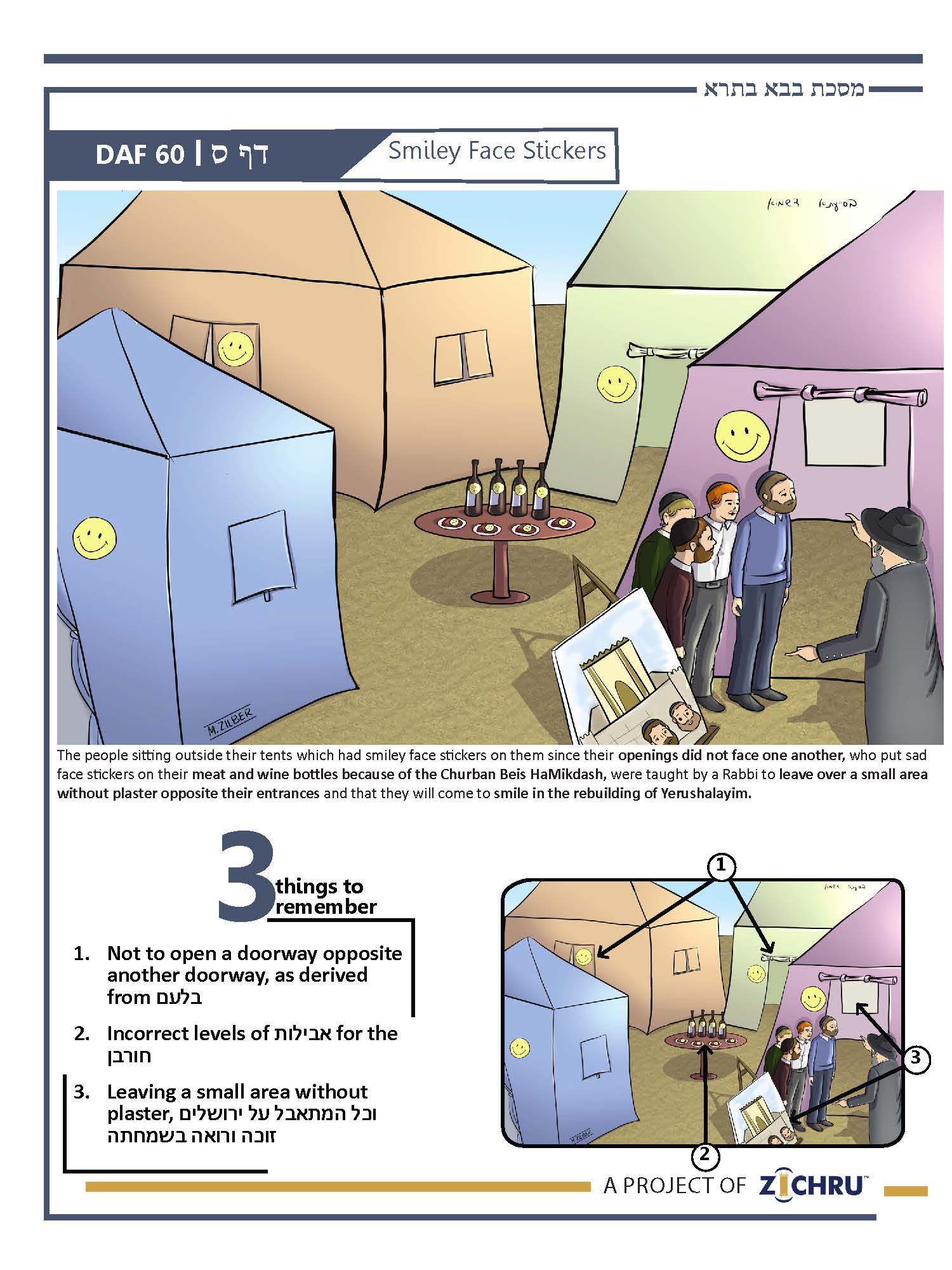Bava Basra - Daf 60
- Audio Timestamps
0:00 - The 3 Sugyos
2:43 - Review of 3 Sugyos
5:12- Siman
8:03 - 4 Blatt Back Chazarah
15:06 - Pop Quiz (Last 7 blatt)
For access to all Zichru resources including PDFs, and illustrations CLICK HERE
- Not to open an opening opposite an opening, as derived from בלעם
The next Mishnah states: לא יפתח אדם לחצר השותפין – A person may not open into a jointly owned courtyard, פתח כנגד פתח – a doorway directly opposite a doorway, וחלון כנגד חלון – or a window directly opposite a window, even if he has a chazakah, for the sake of modesty. Rebbe Yochanan says this is derived from the passuk: וישא בלעם את עיניו וירא את ישראל שוכן לשבטיו – and Bilam raised his eyes and saw Yisroel dwelling according to its tribes and blessed them. מה ראה – What did he see that inspired this blessing? ראה שאין פתחי אהליהם מכוונין זה לזה – He saw that the openings of their tents were not opposite one another, אמר ראוין הללו שתשרה עליהם שכינה – and said, “These people are worth for the Shechinah to rest upon them.”
- The correct level of אבילות for the חורבן
The Gemara relates that when the second Beis Hamikdash was destroyed, many Jews resolved to no longer eat meat or drink wine. They explained to Rebbe Yehoshua: נאכל בשר שממנו מקריבין על גבי מזבח – “Shall we eat meat, from which they sacrifice [korbanos] on the מזבח, and shall we drink wine, which is poured on the מזבח, and now has ceased?!” He responded that if so, we should not consume bread, since flour was used in מנחות, nor fruit, which was brought as ביכורים, nor even water, since the ניסוך המים had ended. They were silent, and he said: בני בואו ואומר לכם – Come, my sons, and I will explain to you what you should do. שלא להתאבל כל עיקר אי אפשר – Not to mourn at all is impossible, שכבר נגזרה גזרה – because the decree to destroy the Beis Hamikdash was decreed and carried out. ולהתאבל יותר מדאי אי אפשר – Yet, to mourn excessively is impossible, שאין גוזרין גזירה על הצבור אא"כ רוב צבור יכולין לעמוד בה – because we do not make decrees on the public which most of the public cannot withstand. He proceeded to enumerate the decrees enacted by the Sages for mourning the חורבן.
- Practices for mourning the Churban, וכל המתאבל על ירושלים זוכה ורואה בשמחתה
Rebbe Yehoshua told them that the Sages said: סד אדם את ביתו בסיד – a person plasters his house, ומשייר בו דבר מועט – and leaves over a small [area] without plaster. This is explained to be a square אמה, and opposite the door. A person should prepare a meal but leave out one item, such as כסא דהרסנא, a dish made of fish fried in its oil with flour. A woman may fully adorn herself, but leave out something small, such as leaving בת צדעא – the hair on her temple, which used to be removed. These practices of mourning have a basis in the passuk: אם אשכחך ירושלים תשכח ימיני תדבק לשוני לחכי וגו' – If I forget you, Yerushalayim, let my right hand wither! May my tongue cleave to the roof of my mouth, etc.
Rav Yitzchak explains the end of the passuk, about setting Yerushalayim "על ראש שמחתי" – above my highest joy, as אפר מקלה שבראש חתנים – ashes on the heads of grooms, which is placed where תפלין are worn on the head. Rebbe Yehoshua concludes: וכל המתאבל על ירושלים – And anyone who mourns for Yerushalayim, זוכה ורואה בשמחתה – will merit to witness its ultimate rejoicing.
Siman – Smiley Face Stickers
The people standing outside their tents which had smiley face stickers on them since their openings did not face one another, who put sad face stickers on their meat and wine bottles because of the Churban Beis HaMikdash, were taught by a Rabbi to leave over a small area without plaster opposite their entrances and that they will eventually come to smile in the rebuilding of Yerushalayim.


